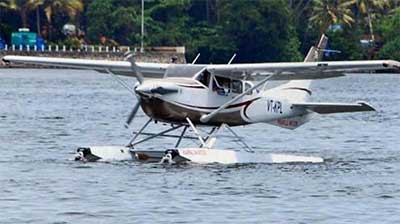Daily-current-affairs
/
26 Oct 2020
India’s First Seaplane Project : Daily Current Affairs

India’s First Seaplane Project
Why in NEWS ?
- The Twin Otter 300 seaplane of Spicejet Technic that took off from Maldives has arrived at
Kevadia Colony in Narmada. The seaplane is scheduled to fly to Ahmedabad where it’ll
commence flying as a part of regional connectivity scheme between Sabarmati riverfront
and Statue of Unity under India’s First Seaplane Project.
About
- If all goes as per plans, India’s maiden seaplane service will be inaugurated by Prime
Minister Narendra Modi on October 31.
- The seaplane has a capacity of 19 passengers, but only 14 passengers would be there
due to payload restrictions.
- The tickets of the flight service would be around Rs 4,800 per person. The
connectivity scheme is being implemented by the terms and conditions of a tripartite
agreement between the state government, MoCA, and Airports Authority of India.
- The release the scheme is being implemented by the terms and conditions of a
tripartite agreement between the state government, MoCA, and Airports Authority
of India.
Seaplane
- A seaplane is a fixed-winged aeroplane designed for taking off and landing on water.
- It offers the public the speed of an aeroplane with the utility of a boat.
- There are two main types of seaplane: flying boats (often called hull seaplanes) and
floatplanes. The bottom of a flying boat’s fuselage is its main landing gear. This is
usually supplemented with smaller floats near the wingtips, called wing or tip floats.
The hull of a flying boat holds the crew, passengers, and cargo; it has many features
in common with the hull of a ship or a boat.
- In India, Jal Hans, a commercial seaplane service based in the Andaman and Nicobar
Islands was launched as a pilot project on 30 December 2010 by the Ministry of Civil
Aviation.
Seaplane Project
- The first of the five seaplane services in Gujarat, connecting Sabarmati River in
Ahmedabad to the Statue of Unity in Kevadia in Narmada district, will be
inaugurated on October 31.
- The first seaplane project of the country is part of a directive of the Union Ministry of
Civil Aviation.
- As per the directive, the Airports Authority of India (AAI) requested state
governments of Gujarat, Assam, Andhra Pradesh and Telangana and the
administration of Andaman & Nicobar to propose potential locations for setting up
water aerodromes to boost the tourism sector.
- In Kevadia, the proposed terminal will be spread over 0.51 acres in the premises of
the Sardar Sarovar Narmada Nigam Ltd., located in the Panchmuli lake (Dyke 3) of
the Sardar Sarovar Dam at Limdi village.
- It is approximately 90 km from Vadodara, 150 km from Surat and 200 km from
Ahmedabad — with an aerial distance of 74.6km from Vadodara airport.
What impact will it have on the environment?
- The water aerodrome is not a listed project/activity in the Schedule to the
Environmental Impact Assessment Notification, 2006 and its amendments. However,
the Expert Appraisal Committee was of the opinion that the activities proposed
under the water aerodrome project may have a similar type of impact as that of an
airport.
- In Narmada, the Shoolpaneshwar Wildlife Sanctuary is located at an approximate
aerial distance of 2.1 km from the proposed project site in south-west direction
while the nearest reserve forest is situated at a distance of 4.7 meters in east
direction, which serves local sensitive species of fauna.
- The bathymetric and hydrographic survey was conducted by Inland Waterways
Authority of India (IWAI) before finalising Dyke 3, which is a rock-filled pond and
popularly called the ‘Magar Talav’ as it is infested with crocodiles. Work on
evacuating crocodiles from the lake has been on since January 2019, after which
mesh fencing of the boundary was also completed to prevent crocodiles from re-
entering from the connecting Dyke 1 and 2.
- The site was finalised for the terminal as its dimensions suit the requirements of
landing the seaplane, which requires a minimum width of 900 metres in a water
body with a depth of at least six feet. Senior engineers of SSNNL added that while a
seaplane does not require any construction of a runway, rubber buoys have been
lined up to indicate the landing path for the seaplane.
- In its proposal seeking environmental clearance, the Director of Aviation,
Government of Gujarat, has allayed fears of environmental impact during the stage
of construction.







